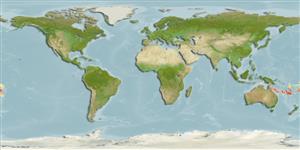Classification / Names
Common names | Synonyms | Catalog of Fishes(genus, species) | ITIS | CoL | WoRMS | Cloffa
Teleostei (teleosts) >
Callionymiformes (Dragonets) >
Callionymidae (Dragonets)
Etymology: Callionymus: Greek, kallion, comparative of kallos = beautiful + Greek, onyma = name; with a better name; kanakorum: Name after the local name of the inhabitants of the islands of New Caledonia, 'kanak' or 'canaque' a word of Polynesian origin.
Eponymy: The Kanaky are an indigenous people in New Caledonia, where the shark and dragonet were first taken. As Séret puts it, the shark is “…dedicated to the Melanesian people of New Caledonia”. (Ref. 128868), visit book page.
More on author: Fricke.
Environment: milieu / climate zone / depth range / distribution range
Ecology
Marine; demersal; depth range 110 - 800 m (Ref. 78107). Tropical
Western Pacific: New Caledonia.
Size / Weight / Age
Maturity: Lm ? range ? - ? cm
Max length : 6.6 cm SL male/unsexed; (Ref. 78107); 6.8 cm SL (female)
Short description
Identification keys | Morphology | Morphometrics
This species belonging to the Callionymus kaianus species-group, has the following characters: 9 unbranched second dorsal and anal fin rays (last one divided at its base); pectoral fin rays 20-22; preopercular spine dorsally with a small antrorse point and two large points which are equal in length; first spine of the first dorsal fin subequal in length with the first ray of the second dorsal fin, mostly with a short filament; margin of the second dorsal fin distally straight in both sexes; caudal fin with no median filaments; third membrane of first dorsal fin with an ocellate black blotch, a basal branch of which may extend to the second membrane; anal fin with a distal dark margin; caudal fin with a large lower and a small upper black area (Ref. 78107).
Inhabits sandy bottoms with few rubble or coralline gravel and sand (Ref. 78107).
Life cycle and mating behavior
Maturity | Reproduction | Spawning | Eggs | Fecundity | Larvae
Fricke, R., 2006. Two new species and a new record of dragonets from New Caledonia (Teleostei: Callionymidae). Stuttg. Beitr. Naturk. Ser. A (Biol.) 696:1-14. (Ref. 78107)
IUCN Red List Status (Ref. 130435: Version 2024-1)
Threat to humans
Harmless
Human uses
Tools
Special reports
Download XML
Internet sources
Estimates based on models
Preferred temperature (Ref.
123201): 12.9 - 20.3, mean 17.2 °C (based on 27 cells).
Phylogenetic diversity index (Ref.
82804): PD
50 = 0.5000 [Uniqueness, from 0.5 = low to 2.0 = high].
Bayesian length-weight: a=0.00891 (0.00410 - 0.01937), b=2.78 (2.60 - 2.96), in cm total length, based on LWR estimates for this Genus-body shape (Ref.
93245).
Trophic level (Ref.
69278): 3.2 ±0.4 se; based on size and trophs of closest relatives
Resilience (Ref.
120179): High, minimum population doubling time less than 15 months (Preliminary K or Fecundity.).
Fishing Vulnerability (Ref.
59153): Low vulnerability (10 of 100).
